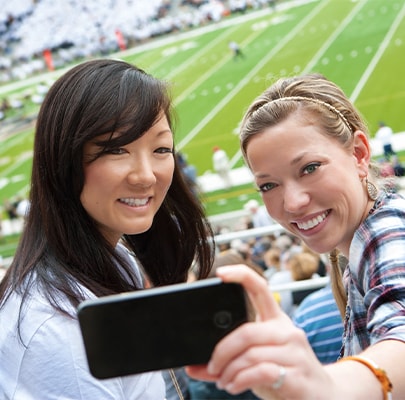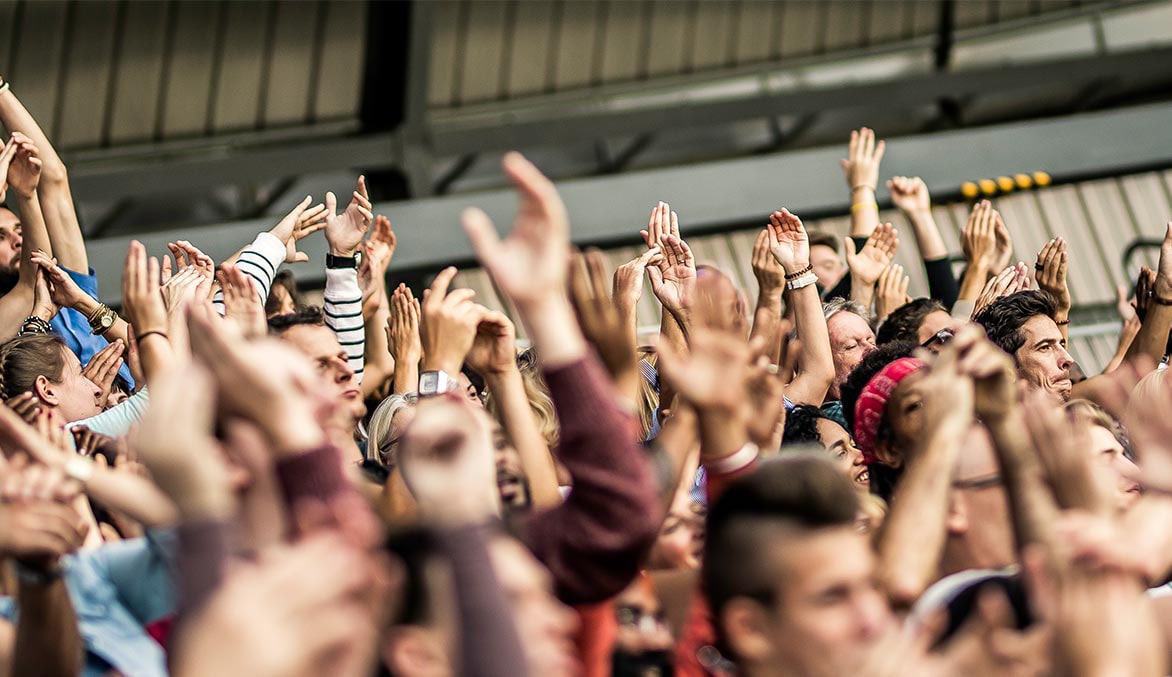March 30, 2022
Professional Football Team Scores Big with Wi-Fi Upgrade
The ubiquity of smartphones has pressured operators of public venues, such as stadiums, to deliver blazing Wi-Fi speeds. CDW can help.
A major U.S. professional football team wanted to provide its fans with fast and seamless Wi-Fi, from the moment they walk past the entrance gates to every square foot of the 68,000-seat stadium — so it turned to CDW to make it happen.
The organization initially blanketed its stadium with Wi-Fi access in 2015, but the original network was designed to support half the venue’s capacity. As more fans began showing up with smartphones, wanting mobile connectivity, the team decided to upgrade its wireless network, adding the latest Wi-Fi 6 access points in 2021 to meet increased bandwidth demands. The network now supports the venue’s entire capacity.

“The team wants to create the best fan experience possible, and a lot of that has to do with providing a great Wi-Fi experience,” says CDW Enterprise Project Manager Dan Morris, who oversaw the wireless project.
Wi-Fi connectivity is an essential part of the fan experience at sporting events today. Attendees want fast and flawless internet access so they can post to social media, check scores, browse the web and stay connected with friends and family while at the game.
Teams also take advantage of Wi-Fi to better engage with fans, personalize the stadium experience and provide conveniences such as mobile ticketing; online ordering for food, beverages and merchandise; and location-based services such as directions to seats and real-time discounts.
Wi-Fi 6: Next-Generation Wireless
Sports franchises typically upgrade the wireless networks in their stadiums and arenas every five to seven years to support next-generation wireless standards and bolster performance for fans, vendors and employees, including players and coaches, says Jay Myers, a CDW wireless solution architect.
The team that engaged CDW for its wireless needs did exactly that.
The franchise, which previously adopted 802.11ac wireless APs, upgraded to Wi-Fi 6, which offers faster speeds, less interference and quadrupled capacity, allowing more people to connect in dense or congested areas — perfect for a sports venue.
“With Wi-Fi 6, more clients can connect at the same time. There’s better throughput and a better experience,” Myers says.
The latest wireless standard also improves the power efficiency of connected devices, meaning batteries on mobile devices that support the Wi-Fi 6 standard will last longer.
Sports Team’s New Wireless Requirements
CDW not only supplied the networking equipment, but also designed and configured the Wi-Fi network and provided onsite support for a handful of games to ensure the new system ran smoothly.
The team’s IT leaders had several goals when they reached out to CDW during the summer of 2020: upgrade to Wi-Fi 6; beef up wireless at the front gates to speed fan entry; add APs in a few locations with spotty Wi-Fi, such as the concourse areas; and move APs from overhead locations and handrails to underneath the seats.
One reason the team’s IT leaders wanted underseat placements of APs was to get better control of wireless signals. In a full stadium, for example, fans’ bodies allow the team to better pinpoint signal coverage. That way, they can install APs closer together in each section, providing fans the high-performance they expect without causing interference.

Designing the Network
CDW designed and built the original Wi-Fi network for the team in 2015, so it had the stadium’s floor plans and knew the existing AP locations. During pre-sales discussions in 2020, Myers used his expertise to design the new network. CDW then dispatched two engineers to perform a site survey at the stadium to finalize the design and make sure APs were placed in the most optimal locations.
“Our design from the pre-sales analysis was pretty close to the final number we ended up with, but the site survey nailed down exactly where the APs needed to be and the exact number that were needed,” says CDW Executive Account Manager Daniel Peterson.
For the new project, CDW increased the number of APs by 50 percent, to 1,466, largely because underseat deployment reduces an AP’s range compared with overhead deployment, so more APs were needed to deliver an optimal experience.
CDW also added some additional APs in the concourse and at the entrance gates to boost coverage in those locations, but the AP locations for the locker rooms, back office areas and private suites stayed the same, Morris says.
50%
The increase in the number of wireless APs deployed as part of the professional sports team’s Wi-Fi upgrade, necessitated by the growing number of fans accessing the network and the club’s decision to move the APs under stadium seats
Standardizing on Cisco
The sports franchise had previously standardized on Cisco equipment, but the IT staff performed its due diligence and explored other vendors. They also asked for CDW’s recommendation for the new wireless network.
CDW advised that they stay with Cisco, explaining it was the best, most cost-effective solution for the organization’s needs — and the team’s IT staff agreed, Peterson says.
The team purchased Cisco Catalyst 9120 Wi-Fi 6 APs, which are managed by two Cisco Catalyst 9800 series wireless controllers. The organization also acquired 10 Cisco Catalyst 9300 series and three Cisco Catalyst 3850 series switches to support the additional APs and to augment the existing switches that were deployed across 42 wiring closets in the first Wi-Fi implementation.
The organization also bought AP antennas, as well as enclosures to prevent underseat APs from getting damaged by rain or when cleaning crews power wash the stadium after games. The IT staff also purchased licenses to Cisco DNA Center network management software, which provides a dashboard to manage, monitor and troubleshoot the network.
No Longer a Nice-to-Have
Professional sports teams and stadium owners across the country are under ever-increasing pressure to deliver fast, reliable game-day Wi-Fi access, because fans continue to demand more. For example, data transfer volumes at the U.S. professional football championship game have almost tripled since 2017, according to Extreme Networks:
12 TB
2017
16 TB
2018
24 TB
2019
26 TB
2020
14 TB
20211
32 TB
20222
Sources: 1extremenetworks.com, "Wi-Fi Engagement Insights from Super Bowl LV," Feb. 12, 2021 (Due to the pandemic, only 25,000 fans attended the game, yet Wi-Fi data was still higher than it was just four years earlier.); 2extremenetworks.com, "NFL Sets Record for Most Digitally Engaged Fans Throughout 2021/22 Season," March 3 2022
Installing the Gear
The sports team hired its own electricians to install the new Wi-Fi APs, a job that included drilling holes in the concrete to run CAT 6 copper wiring to each of the new APs underneath the seats.
CDW network engineers were on hand during the process, installing and configuring the network switches and wireless controllers and configuring the APs once they were installed.
The Wi-Fi deployment was staggered because of supply chain issues. A shortage of semiconductors and other components have caused delivery delays throughout the tech industry, and networking equipment was affected.
CDW’s sales team was on the phone with Cisco every week to ensure APs were delivered as soon as possible, and Cisco came through, delivering the APs in a handful of shipments over the course of several months, Peterson says.
“We had to escalate it to Cisco and get them involved,” he says. “It became a just-in-time model, where we weren’t able to get them all at once. But we’d get 250 to work with, and then a few weeks later, we’d get another shipment of 250, and so on. Eventually we were able to get them all out there.”
CDW Optimizes New Wi-Fi Network
The wireless installation took several months. The work began in the off-season and was completed about six weeks into the season.
The electricians installed new APs in the concourse, private suites and the back-of-house areas such as the locker rooms, and the team turned them on first. Then the installers tackled the bowl of the stadium, where 70 percent of the APs are located.
A CDW team was onsite throughout the installation process to ensure each AP was installed in the right section and under the correct seat. The CDW senior wireless engineers who performed the site survey, Joe Arnold and Brian Thusius, worked with Morris throughout the process. “We walked the stadium with our laptops to make sure the APs were named properly and configured in the proper groups,” Thusius says.
When the season began, CDW and the team’s IT department kept the old Wi-Fi system working and cut over to the new network as each portion was completed, Morris says.
CDW created multiple SSIDs and virtual LANs: a guest network for fans and password-protected networks for the team’s back-office support and for Ticketmaster, which manages the mobile ticketing system, Morris says.
CDW’s professional services team attended five games to monitor the Wi-Fi network during the installation and after it was completed. They roamed the stadium, tested for dead spots and slow connections, and fine-tuned the APs in each section to maximize performance.
For example, Morris would sit in a section and connect to the Wi-Fi with four different cellphones, while Thusius or Arnold park themselves nearby and used a laptop to measure performance, such as signal strength and how much traffic moved through each AP.
They’d run commands on a wireless controller to make sure Morris’s phones connected to the closest AP, not to one farther away. They checked each phone’s status and made sure they had good bandwidth and examined how many devices connected to each AP in each section, Arnold says.
“We can see how many devices are on an AP, and if an AP is overloaded, we can tune the power down and tune up the neighboring AP’s power a bit,” Arnold says. “It’s fine-tuning and balancing things up.”
Improved Wi-Fi Experience
About 40,000 fans connected to the new Wi-Fi network during each game of the 2021 season and enjoyed blazing-fast speeds. Apps and web pages loaded quickly, while video calls were smooth, with no jitter. The Wi-Fi also takes the load off cellular networks, which improves phone service inside the stadium.
Fans are elated with the new Wi-Fi network. In fact, while testing and fine-tuning APs during games, Thusius heard fans praise the new state-of-the-art network.
“When we walked up to the upper bowl and sat down to survey the Wi-Fi, several times fans saw us with our CDW shirts and asked, ‘Are you with CDW?’ We said yes, and they said, ‘Wi-Fi is awesome,’” he says.
Overall, the Wi-Fi network is performing as designed and meeting the team’s expectations, Peterson says.
“The team is very happy with the deployment,” he says. “We had the cards stacked against us with the timelines and the industry constraints. But CDW overcame all that and did a knockout job. It was a fun project.”
Story by Wylie Wong
Getty Images: vm (fans mobile devices), nycshooter (selfie), vm (fans)
MKT52973
